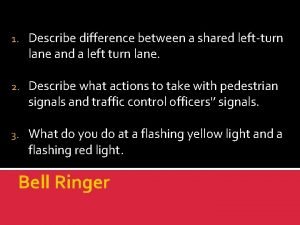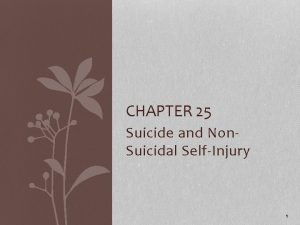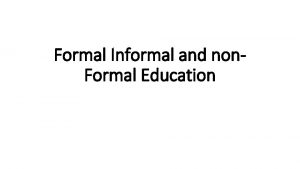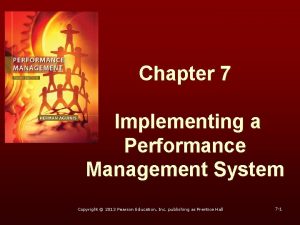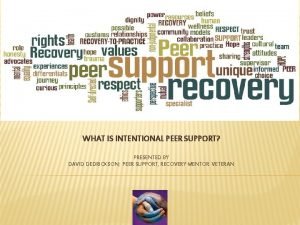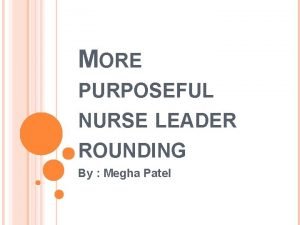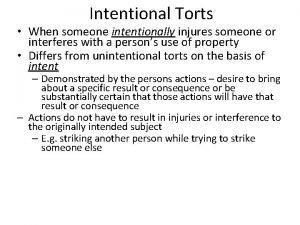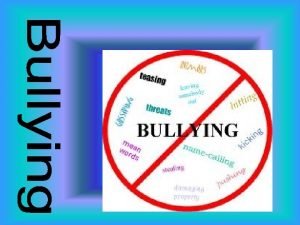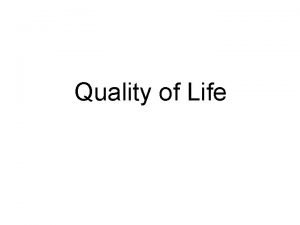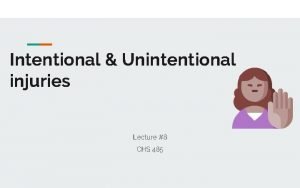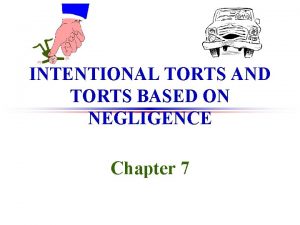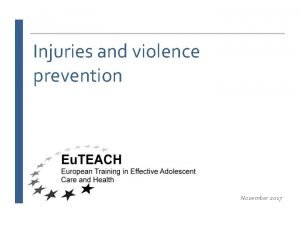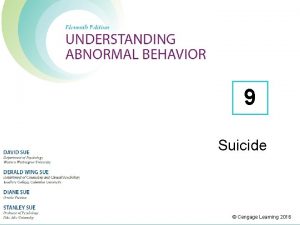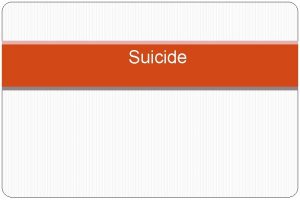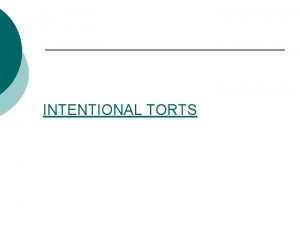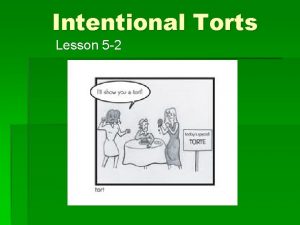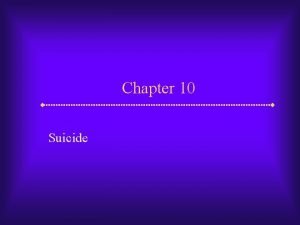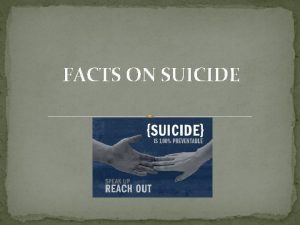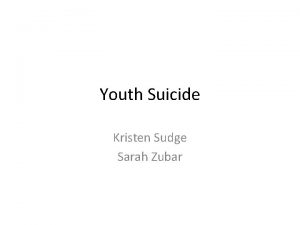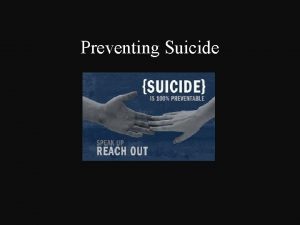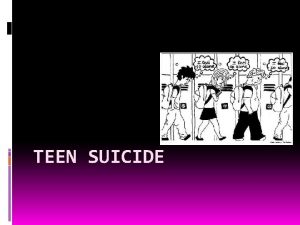Chapter Eight Suicide Suicide Suicide The intentional direct






































- Slides: 38

Chapter Eight Suicide

Suicide • Suicide: – The intentional, direct, and conscious taking of one’s own life – Not classified as a mental disorder, although the suicidal person usually has psychiatric symptoms, such as: • Depression, alcohol dependence, and schizophrenia – Suicide and suicidal ideation (thoughts about suicide) may represent a separate clinical entity

Correlates of Suicide • Psychological autopsy: – Systematic examination of existing information to understand explain a person’s behavior before death – Suicide survivors are different from those who succeed: • Typical attempter: White female housewife in 20 s-30 s with marital difficulties; uses barbiturates • Typical succeeder: Male in 40 s or older with poor health or depression; uses gun or hangs himself

Facts About Suicide • Frequency: – Approximately 34, 000 people commit suicide each year – Among top 11 causes of death in industrialized parts of the world – Number of actual suicides is probably 25 -30% higher than what is recorded

Facts About Suicide (cont’d. ) • Suicide publicity/identification with victims: – Media reports of suicide, especially celebrity suicide, spark increase in suicide – Suicides by young people in small communities evoke copycat suicides • Gender: – Men are about four times as likely to be successful (they use more lethal means) – Women are more likely to attempt suicide

Facts About Suicide (cont’d. ) • Marital status: – Married people are less vulnerable – Divorced and widowed individuals are more vulnerable • Occupation: – Higher risk for physicians, lawyers, law enforcement personnel, and dentists – Burnout, stress, and guilt over medical errors may increase risk for surgeons

Facts About Suicide (cont’d. ) • Socioeconomic level is not a factor • Choice of method: – Over 50% of suicides are committed using firearms – 70% of attempts are from drug overdose – Most common means for children under 15 is jumping from buildings and running into traffic – Most common means for adolescents over 15 is drug overdose or hanging themselves

Facts About Suicide (cont’d. ) • Religious affiliation: – Correlated with suicide rates – Suicide rates are lower in Catholic and Muslim countries where there is strong condemnation of suicide – Where religious sanctions are weaker—e. g. , Scandinavian countries, former Czechoslovakia, Hungary—suicide rate is higher

Facts About Suicide (cont’d. ) • Ethnic and cultural variables: – Highest rates in U. S. are for American Indian; lowest for Asian Americans – High rates of alcoholism, low standard of living, and invalidation of cultural lifestyles also contributing factors

Facts About Suicide (cont’d. ) • Historical period: – Tends to decline during times of war and natural disasters – Increase during periods of shifting norms and values or social unrest • Communication of intent: – More than two-thirds of those who commit suicide communicate their intent to do so within three months of the act

Facts About Suicide (cont’d. ) • Reinforcing protective factors: – Reawakening and reinforcing desire to live – Expanding perceptual outlook by reducing suicide myopia – Enhancing social connectedness – Increasing repertoire of coping skills

A Multipath Perspective of Suicide • Most viable explanation of mental disorders must come from an integrated and multidimensional analysis • Many different factors involved in suicide – Biological – Psychological – Sociocultural

Biological Dimension • Suicide influenced by low serotonin levels in the brain – 5 -hydroxyindoleacetic acid (5 HIAA): • Produced when serotonin is broken down in the body • Low amounts of 5 -HIAA in suicidal patients • Genetics: – High rate of suicide and suicide attempts among parents and close relatives of individuals who attempt or complete suicide – Unclear relationship

Psychological Dimension • Depression and hopelessness: – Depression plays important role; relationship is complex – Increase in sadness is a frequent mood indicator of suicide – Heightened feelings of anxiety, anger, and shame also associated – Hopelessness, or negative expectations about future, may be even stronger factor

Psychological Dimension (cont’d. ) • Alcohol consumption: – One of most consistent correlates • As many as 70% of suicide attempts involve alcohol – Also strong correlation to successful attempt – May lower inhibitions related to fear of death – Alcohol-induced myopia: a constriction of cognitive and perceptual processes – May increase distress by focusing thoughts on the negative aspects of their personal situations

Social Dimension • Many suicides are interpersonal in nature and are influenced by relationships involving a significant other • Individuals who are incapacitated or have a terminal illness are often at higher risk • Family instability, stress, and chaotic family atmosphere related to attempts by younger children

Social Dimension (cont’d. ) • Interpersonal-psychological theory of suicide (Joiner): – Perceived burdensomeness – Thwarted belongingness – Acquired capacity for suicide • Social factors that separate people or make them less connected to other things they care about (e. g. , family religious affiliation, etc. )

Sociocultural Dimension • Emile Durkheim: – Inability to integrate oneself into society; lack of close ties deprives one of support systems necessary for adaptive functioning • Other factors: – Modern mobile society that de-emphasizes importance of family and sense of community – Further group goals or achieve greater good – Social change and disorganization within one’s community

Suicide and Specific Populations • Three groups of people affected by suicide: – Children and adolescents – College students – Elderly people

Suicide Among Children and Adolescents • Suicide rate for children under 14 is increasing at alarming rate • Suicide is third leading cause of death among teenagers • Teen suicide increased by 18% in 2004 and by 17% in 2005 • High school study: 13. 8% considered suicide, 6. 3% attempted, and 1. 9% required medical attention

Suicide Among Children and Adolescents (cont’d. ) • The role of bullying: – “Bullycide”: bullying leading to suicide – Bullying victims are 2 -9 times more likely to consider suicide than non victims – Nearly 50% of young people who commit suicide experienced bullying • Copycat suicides: – Youngsters mimic a previous suicide – Highly publicized suicides increase the number of attempts

Suicide Among Children and Adolescents (cont’d. ) • Decrease in antidepressant medication: – 2004 FDA warning of an increased suicide risk for children taking SSRI antidepressants – Recent research suggests SSRIs may increase suicidal thoughts or behaviors for very select few – Increase in youth suicide rates since FDA warning because antidepressants are less likely to be prescribed

Suicide Among College Students • According to study, suicide rates among college students are no higher than noncollege group but: – Limited access to lethal means – Decreasing proportion of males attending college – Nearly 1, 000 students commit suicide per year – 44% increase in students with psychiatric disorders – Between 2009 and 2010 serious thoughts of suicide among college students rose significantly

Suicide Among College Students (cont’d. ) • College study: – More than 50% reported suicidal thoughts – 14% of undergraduates and 8% of graduates had made a suicide attempt • Development of programs and resources to: – Identify warning signs – Have well-established suicide prevention procedures – Clearly identify resources for a suicidal crisis

Suicide Among the Elderly • Unwelcome physical changes, including wrinkling, graying hair, and diminished physical strength • Life events connected with “feeling old” lead to depression (one of the most common psychiatric complaints of the elderly) • Suicide rates for elderly white men are the highest for any age group

Suicide Among the Elderly (cont’d. ) • Firearms are most common method for people over 65 years old • Elderly make fewer attempts per completed suicide • For Asian Americans, the highest risk is for first -generation immigrants • Lowest rates among American Indians and African Americans

Preventing Suicide • Assumption that potential victims are ambivalent: they have a strong wish to die, but also a wish to live • Part of success in prevention is ability to assess lethality: – The probability that a person will choose to end his or her life

Preventing Suicide (cont’d. ) • Three-step process for working with a potentially suicidal person: – Knowing which factors are highly correlated with suicide – Determining probability that person will act on suicide wish (high, moderate, or low) – Implementing appropriate actions • Attempt to quantify the seriousness of each factor

Clues to Suicidal Intent • Demographic: – Male, increased age, and history of suicide threat • Specific: – Amount of detail in the threat – Direct access to means of suicide – Precipitating events – Verbal communication of intent (often this is subtle) – “Practice run” at an actual attempt

Clues to Suicidal Intent (cont’d. ) • Indirect behavioral cues: – Puts affairs in order; takes a long trip; gives away prized possessions; etc. • Early signs: – Depression, guilt feelings, insomnia, tension, nervousness, loss of weight, and impulsiveness • Critical signs: – Sudden changes in behavior; gives away possessions; threats or actual attempts

Clues to Suicidal Intent (cont’d. ) • Crisis intervention: – Clinical level: • Educate staff at mental health institutions and schools to recognize signs of potential suicide – Crisis intervention aimed at providing intensive short-term help to resolve immediate life crisis • Patient may be immediately hospitalized, given medical treatment, seen by psychiatric team for two-four hours per day until stabilized • Working with patient and taking charge of person’s personal, social, and professional life outside facility

Clues to Suicidal Intent (cont’d. ) Figure 8 -2 The Process of Preventing Suicide prevention involves the careful assessment of risk factors to determine lethality- the probability that a person will choose to end his or her life. Working with an individual who is potentially is a three-step process that involves (1) knowing what factors are highly correlated with suicide; (2) determining whethere is high, moderate, or low probability that the person will act on the with; and (3) implementing appropriate actions.

Clues to Suicidal Intent (cont’d. ) • After clients return to more stable emotional state and immediate risk has passed: – Traditional forms of treatment, inpatient or outpatient, are used – Relatives and friends may be enlisted to help monitor individual

Suicide Prevention Centers • Many in acute distress are not being treated and may be unaware of available services • Telephone crisis intervention: – Maintain contact and establish relationship – Obtain necessary information – Evaluate suicidal potential – Clarify nature of stress and focal problem – Assess strengths and resources – Recommend and initiate action plan

Suicide Prevention Centers (cont’d. ) • Today, there about 200 suicide prevention centers in U. S. , along with many suicide hotlines • Little research has been done on effectiveness (anonymity)

The Right to Suicide • A majority of Americans believe terminally ill individuals should be allowed to take their own lives • Suicide is both a sin and an illegal act in most countries • Oregon (1998): – Physician-assisted suicide act – U. S. Attorney General Ashcroft attempted to overturn (U. S. Court of Appeals upheld Oregon’s law)

Moral, Ethical, and Legal Implications • Recent legislation and literature has debated whether it is morally, ethically, and legally permissible to aid in suicide – Derek Humphrey’s Final Exit (1991): • Hemlock Society’s manual on suicide – Doctor Jack Kevorkian: • “Dr. Death” and his “suicide machine” • Ironically, by prolonging life, medical science has also prolonged the process of dying

Moral, Ethical, and Legal Implications (cont’d. ) • Pro: – Suicide can be a rational act; mental health and medical professionals should be allowed to help without fear or legal or professional repercussions • Con: – Suicide is not rational, and it is dangerous to say that it is • Criteria to decide between life and death: – “Quality of life” and “quality of humanness” are subjective and difficult to define
 Flat shape with eight sides
Flat shape with eight sides A short section of corrugated roadway that warns of hazards
A short section of corrugated roadway that warns of hazards Chapter 5 lesson 3 suicide prevention answer key
Chapter 5 lesson 3 suicide prevention answer key Chapter 25 suicide and nonsuicidal self injury
Chapter 25 suicide and nonsuicidal self injury Does nick actually like gatsby chapter 8
Does nick actually like gatsby chapter 8 Lord of the flies chapter 8 review
Lord of the flies chapter 8 review Intentional injury examples
Intentional injury examples How to protect yourself from intentional injuries
How to protect yourself from intentional injuries Self assessment of modes questionnaire
Self assessment of modes questionnaire Intentional fallacy example
Intentional fallacy example Define formal education
Define formal education Jennifer joan thompson
Jennifer joan thompson Pilot testing in performance management
Pilot testing in performance management Intentional amoral management
Intentional amoral management Principles of peer support
Principles of peer support Intentional use of unfriendly or offensive behavior
Intentional use of unfriendly or offensive behavior Example of tort
Example of tort Conventional approach to business ethics
Conventional approach to business ethics The creative curriculum for infants toddlers and twos
The creative curriculum for infants toddlers and twos Plagiarismn
Plagiarismn Intentional relationship model
Intentional relationship model Daily intentional nurse leader rounding on patients
Daily intentional nurse leader rounding on patients Intentional tort
Intentional tort Definition food adulteration
Definition food adulteration Intentional slut behaviour
Intentional slut behaviour Intentional misstatement
Intentional misstatement Levels of communication
Levels of communication Unintentional injury examples
Unintentional injury examples Wassell v adams
Wassell v adams Example of intentional injury
Example of intentional injury Intentional christian living
Intentional christian living Hát kết hợp bộ gõ cơ thể
Hát kết hợp bộ gõ cơ thể Frameset trong html5
Frameset trong html5 Bổ thể
Bổ thể Tỉ lệ cơ thể trẻ em
Tỉ lệ cơ thể trẻ em Chó sói
Chó sói Thang điểm glasgow
Thang điểm glasgow Chúa yêu trần thế
Chúa yêu trần thế Môn thể thao bắt đầu bằng từ chạy
Môn thể thao bắt đầu bằng từ chạy

